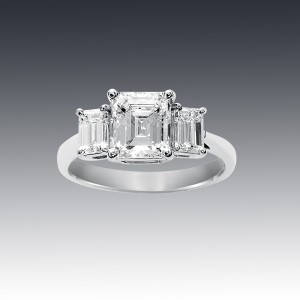Many contemporary jewelry designs, especially those made of white gold are electroplated in rhodium to enhance their shine and durability. Here is an explanation of this process, and some tips on maintaining your gold and platinum jewelry.
It is important to be aware that rhodium plating does not last forever. The plating on something that takes a lot of wear, like a wedding ring, can wear away in as little as two years, or last more than 10 years. A necklace or pin that is worn less frequently or comes in less contact with your skin or the elements can keep its plating for ten to 20 years. You can tell when the plating is wearing away by the look of the piece; the area without the plating will show the yellowish color of the original white gold. Discoloration can also occur on the unplated areas, and in some rare instances, your skin will have a slight reddening reaction to the exposed alloy.
In that case, a quick trip to the jeweler is all it takes to bring your piece back to life. Most jewelry items can be easily replated, although replating a two-toned piece will be more expensive because the work needs to be done by hand. Prices will also vary according to the thickness of the rhodium plate that you choose to use, the thicker the plating, the more metal is used, therefore the more expensive the process is. Choose thicker layers for items you wear every day, like a wedding or engagement ring. The extra one-time expense will be well worth it in the long run, because you won’t have to have the item replated as frequently.
Make sure your jeweler is planning on cleaning and polishing your jewelry before it is replated. The smoother the piece is to start with, the better the effect you will get from the replating process.
Sometimes, platinum or silver jewelryis rhodium-plated. In the case of platinum, it is because rhodium is a bit brighter than platinum, so it is used to enhance the shine. For silver, it is a little bit different. Silver is actually more reflective (shinier) than rhodium, but silver is also a much softer metal, and can be scratched very easily. So the owner of a rhodium-plated silver piece is trading a small bit of shine for a longer, scratch-free life.
When the plating begins to wear away from a platinum or silver piece, it will be much less noticeable-the color difference is not as great, because the metal underneath will appear to be gray, not yellowish. Silver can tarnish, but platinum won’t, and neither sterling silver nor platinum will cause a skin reaction if exposed. In this case, have the item replated when the look of it is bothersome.
If you are shopping for a new piece of jewelry in white gold, platinum, or silver, be sure and ask the jeweler if the item has been rhodium plated. Often, customers buy rhodium-plated pieces without realizing it-knowing how your new jewelry was made will help you maintain it properly and enjoy its beauty for years.

